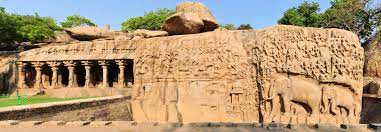A scenic sea-side heritage site of Mahabalipuram in Tamil Nadu state of India showcases centuries of rich cultural history.
Mahabalipuram or Mamallapuram is an ancient city in Tamil Nadu state in southern India, 50 km south west of Chennai, capital of Tamil Nadu. It was a prosperous trading seaport city on the Bay of Bengal during as early as 1st century AD and was used as a landmark for navigation of ships. Mahabalipuram was part of a Tamil dynasty called Pallava Dynasty during 7th to 9th centuries AD and was most part it was their capital city. This dynasty ruled over southern India and this period was called the golden age.
Mahabalipuram is believed to be named after the king Mahabali who sacrificed himself to Vamama, the fifth incarnation of Lord Vishnu in Hinduism for attaining liberation. This is documented in the ancient Indian text called Vishnu Puran. The word “puram” is a Sanskrit word for a city dwelling. So Mahabalipuram is literally translated as ‘city of great Bali”. The city is known for its silvery white sandy beaches, literature and art and architecture comprising of exquisite stone carved sculptures, temples and is a UNESCO World Heritage site.
The Pallava kings of Pallava dynasty were very powerful and philosophical thinkers who were known as patron of the arts. They constructed a complex of seven temples commonly known as ‘Seven Pagodas of Mahabalipuram’ and the main credit for founding this complex goes to Pallava King Narsimha Varman II. Mamallapuram is also thought to have been named after him as he got the title of Mamallan or ‘the great wrestler’.
The oldest mention of these temples as ‘Pagodas’ has been when this was used as a beacon to guide sailors to the coast when coming to India. These exquisite granite temples on picturesque shores of Bay of Bengal are all located in Mahabalipuram are now thought to be submerged except one is visible today called the Shore temple dedicated to Shiva and is considered to be one of the oldest temples in India.
The shore temple is literally named so because it lies on the shore of Bay of Bengal though this name has been assigned now and its original name is still unknown. This temple, entirely made of black stone is a five-storeyed pyramid shaped building built of cut stones with 50 ft square base and 60 ft height. It is the earliest known free-standing temple in Tamil Nadu state. The positioning of this temple is such that the first rays of the sun in morning fall on the deity in the east facing shrine. The temple is adorned with intricately designed bas-reliefs.
Visitors enter the temple premises through a gateway. There are several monolithic sculptures present around the temple complex. There are around hundred Nandi statues in the complex and each one is carved out of a single stone. The Nandi bull was highly worshipped in ancient India. It is believed that the remaining six temples have been submerged in water somewhere off the coast of Mahabalipuram. The bent of Pallava kings towards creativity absolutely shows through the rich and beautiful architecture at Mahabalipuram. The richness of cut caves, temples carved out of single rocks, bas-reliefs reflect their artistic creativity.
Many underwater expeditions, excavations and studies have been conducted since 2002 by Archaeological Society of India (ASI) in collaboration with international agencies and by taking Navy’s generous help to uncover information about the submerged temples. Underwater expeditions are extremely challenging and divers have found fallen walls, broken pillars, steps and also blocks of stone scattered over a large area though lying undisturbed.
During a tsunami on the eastern coast of India in 2004, city of Mahabalipuram was water-logged for days and all structures around temple suffered substantial damage. However, this tsunami also unearthed the archaeological treasures which had been hidden in the sea for centuries. During the tsunami when the sea briefly pulled back around 500 m, ‘long straight row of rocks’ was seen to emerge from the water before being covered once again. Also, certain hidden or lost objects were washed ashore when tsunami waves receded and removed the sand deposits which had covered such structures, example a big stone lion and an incomplete rock elephant.
The rich history of Mahabalipuram is already well reflected owing to the widespread traditional sculptures in neighbourhood dwellings and interestingly they are being built today with similar techniques that were used long time ago. Such discoveries have renewed interest in Mahabalipuram and investigations are ongoing to unravel questions and theories about the city’s past.
***























